Native Plant Road Trip to Austin
Coralberry and Texas Mountain Laurel
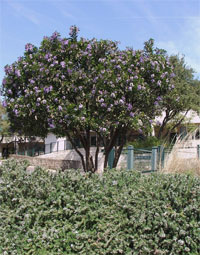
Texas mountain laurel, adorned in spring blooms. All photos by Steven Chamblee.
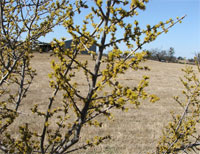
Elbow bush in bloom.
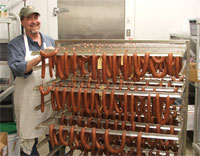
The “magnificent meatatorium.”
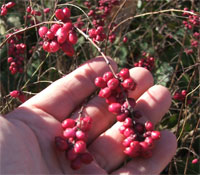
Coralberry.
I finally found a little time to break out of the garden and go down to Austin … and just in time. Gardens can be strange places at times — sanctity one day, prison the next. Late winter and early spring at Chandor Gardens has brought with it not only the wondrous barrage of bulbs, buds, and blooms, but also the bane of broken pipes and the pain of pooped-out pumps. My spine aches from playing Hunchback, my hands are stained from primer and glue, and my brain is tired from the sheer volume of it all. Thank God and Willie Nelson for the road trip!
Slipped south out of town on good ole Tin Top Road, gliding past the elbow bush in bloom, the only time when people ever really notice it. The small, greenish-yellow flowers create fuzzy clusters around the stems, attracting bees and other late winter pollinators. Once out of bloom, it sort of melts into the fence lines as just some other indistinct green shrub. I guess even plants have their 15 minutes of fame.
By the time I rolled into the tiny town of Hamilton, I was getting pretty hungry. I turned left a block before the courthouse square and ran smack dab into a big ole banner that read, “Butt … It’s What’s for Lunch.” Naturally, I had to check this out. What I discovered was true Nirvana, except they call it Wenzel Lonestar Meat Company. I was a day early for “Pork Butt Friday,” so I had to “settle” for a killer ham and cheese with meat piled up halfway to the ceiling, served up by the nicest folks around. Kent Wenzel himself told me the story of how that enormous buffalo head came to be hangin’ off the wall, and even gave me the royal tour of the “magnificent meatatorium” (my term, not his), a haven free from preservatives, fillers, and non-natural nonsense. Hmmm … imagine that.
I was still glowing from the visit when I noticed Hamilton still has an old one-screen movie theater … and it’s still in business! Now there’s something you don’t see everyday. So I’m in the process of pulling over when I spy something even rarer … a huge mass of coralberry in full fruit. Now coralberry (Symphoricarpos orbiculatus) is a true native Texas treasure, and like most other true Texans, escapes easy description. Technically, it’s probably a shrub, but most of the time it grows more like a groundcover, with thin, arching stems that generally max out at about 30 inches tall, but have been known to reach 6 feet. The inch-and-a-half-long, orbit-shaped leaves are deciduous and grow opposite each other along the stems, partially obscuring the developing fruit until after the first hard freeze of winter. Once the leaves fall off, coralberry really shines. The pea-sized fruits cluster together around the stem, and can range from coral-red to deep pink to even purple in color. This mass was especially rare, because it started in someone’s front yard and continued on between the sidewalk and the street. Almost anywhere else but this nice little enlightened town, some neat-nick neighbor would be out there having a raging conniption about something other than shorn grass out by the street. Apparently, folks in this town recognize and treasure the natural botanical heritage of the Lone Star State. Hmmm, imagine that.
Once in Austin, I toured the city extensively, and repeatedly, as is the case for almost every out-of-towner trying to find their flippin’ hotel. (“Breathe deep and relax, Big Fella, you’ve only been driving around in circles for two hours….”) Luckily, good friends at Zilker Botanical Garden talked me down, and my buds at the Ladybird Wildflower Center smoothed me out. The two days went by in a flash, and I’m heading north out of town on Bee Caves Road after a quick 90-minute stop at the awesome Barton Springs Nursery. All of a sudden, I spot her up ahead, boldly standing right beside the road in nothing but all the glory that God gave her. Precocious little thing, she was, too, for her sisters were not yet flaunting it all for everyone to see. She didn’t care in the least about being such a spectacle, so naturally, I had to stop and take pictures. Hmmm, imagine that.

Texas mountain laurel blossoms.
Texas mountain laurel (Sophora secundiflora) is a shrubby, evergreen tree that lets it all hang out every spring. (What did you think I was talking about?) She flat out smothers herself in those huge, fabulous clusters of sumptuous blossoms that resemble plump wisteria inflorescences and smell simply divine. The debate continues about whether their fragrance more closely resembles grape bubble gum or grape Kool-Aid, but either way, they are amazing. The flowers eventually fade and are replaced by thick, leathery seed capsules that contain one to five large, lovely, burgundy-colored seeds. These seeds are famous for their toxicity, but since the seed coat is so hard, it’s unlikely anyone would ever get accidentally poisoned by one. Texas mountain laurel eventually grows to about 16 feet tall and makes an absolutely superb small ornamental garden tree. Two caveats here — one, the tree is questionably winter hardy in Zone 7; and two, they are notorious for being difficult to transplant and seem to resent the comforts of cultivation. Sounds like a relative of mine. Hmmm, imagine that.
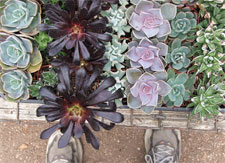
“Weird plants” at Spicewood Spines.
So I’m easing on up Hwy 71, coming up on the town of Spicewood, when I see a little bitty sign by the road that says, “Weird Plants, 1 Mile.” I’m hooked already. Spicewood Spines Cactus Nursery and Art Gallery … what more could you want? An hour later, I’m loading one triquetrous and a few fasciated euphorbias* in the back of the truck. I breathe deep … the air is full of grape bubble gum and ham sandwiches. The days of aching back and purple fingers seem years ago. The road trip has once again performed its magic. Hmmm, imagine that.
* Five-dollar words dedicated to the Parker County Master Gardeners, who I know will look them up and tell me about the other things they learned while doing so.
About the author: Steven Chamblee is the chief horticulturist for Chandor Gardens in Weatherford and a regular contributor to Neil Sperry’s GARDENS magazine and e-gardens newsletter. He adds these footnotes:
Chandor Gardens Spring Fling!!!
Please join us at Chandor Gardens for our annual Spring Fling weekend. This year’s event will feature:
• Master Gardener information booth
• Plant sale
• Face painting
• Artist painting in the garden
• Live music
• Light refreshments for sale
• Chandor Gardens memorabilia on display
• Chandor Gardens gift shop open
• Lectures by Texas Bee Charmer Janet Rowe and Chandor Gardens Horticulturist Steven Chamblee
• Unveiling of the restored dragon fountain
When: April 4 and 5. Where: Chandor Gardens, 711 West Lee Avenue, Weatherford , Texas. Hours: Saturday 9 a.m. – 3 p.m.; Sunday 1 – 5 p.m. Admission: ONLY $1, just like Ina charged in 1969. Children 12 and under admitted FREE! Lecture Times: Texas Bee Charmer Janet Rowe: Saturday, 11 a.m. Horticulturist Steven Chamblee: Saturday, 1 p.m. Please call 817-613-1700 or e-mail knantz@weatherfordtx.gov for more information on this event. Be sure to check out www.chandorgardens.com for the whole scoop on Chandor Gardens.

